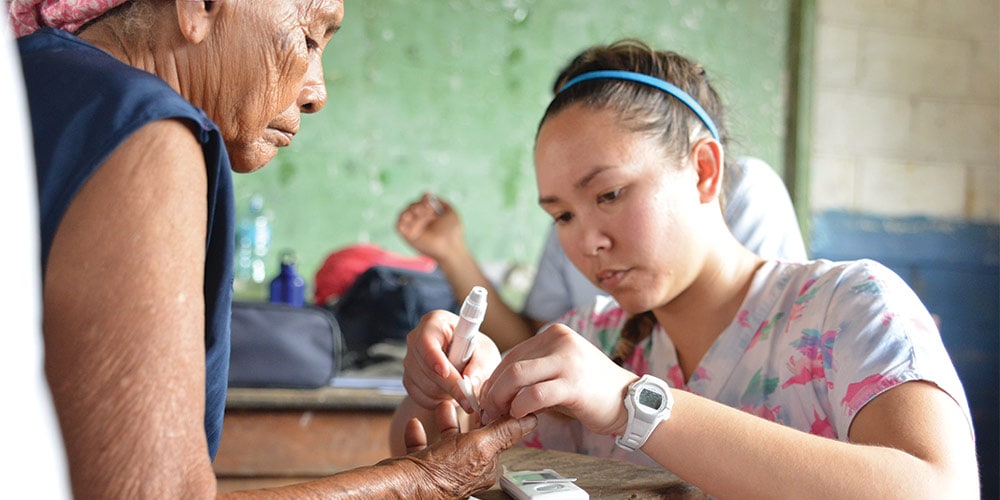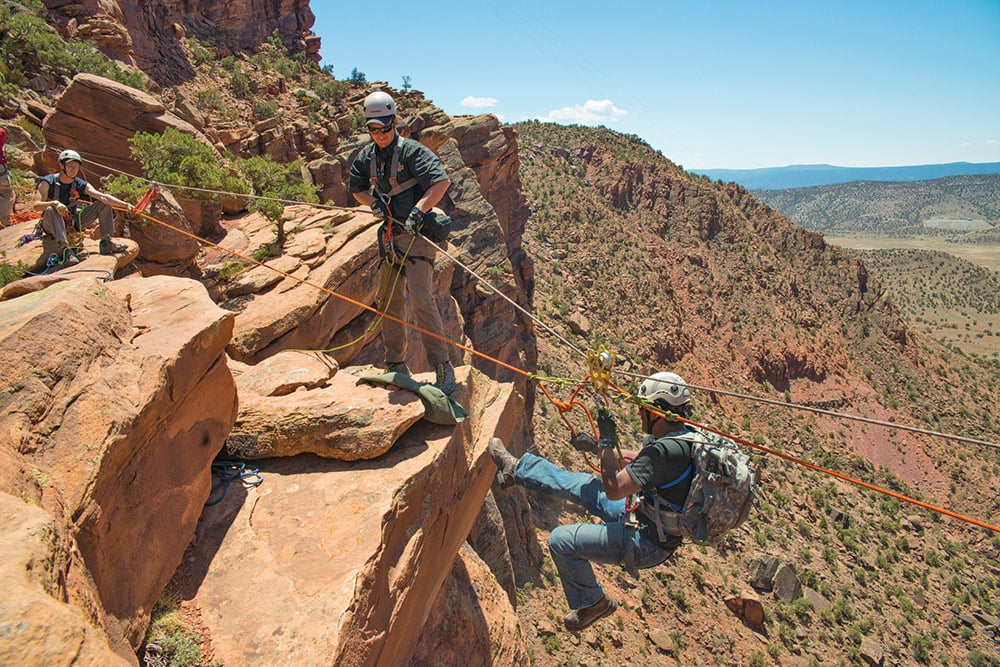
The first thing that strikes you when you enter the office of Rich Carlson, Union College’s chaplain of 37 years, is his collection of loons. Big ones, small ones, carved ones, plastic ones—they line office shelves and adorn his desk.
“I’ve never bought a loon in my life,” Carlson says, laughing. “They’ve all been given to me during the years I’ve been here. There are about 1,000 of them.”
The same longevity that has allowed Carlson’s loon collection to grow throughout nearly four decades of coordinating the college’s religious activities and programs has also provided the stability and continuity to retain and grow the school’s historic reputation of strong mission emphasis.
“I credit a lot of our focus on mission and outreach to our campus ministries team, which has been led by one chaplain for many years,” says college president Vinita Sauder, who accepted the call to be president of Union College in Lincoln, Nebraska, in July 2014. “Pastor Carlson is a steady, faithful, God-fearing leader, and he imparts that mission emphasis to his entire campus ministries team.”
Sauder says that one of the draws for her to accept the call to Union’s smaller college campus following a long career in various roles at Southern Adventist University—the most recent being vice president for strategic initiatives—was the school’s environment of faculty and student mentorship. This included its emphasis on training students for mission.
“Union College has a longstanding culture of what I’ll call head, heart, and hands,” she says. “We’re not only educating the head, we’re also building the heart in a relationship with Christ, and using the hands to experience the joy that comes from actually serving others. It’s a pervasive culture; it’s in our DNA.”
If someone were to doubt the college’s commitment to mission, they would need only to note the nearly 10-foot-long encased plaque hanging in the lobby of the administration building. The plaque incorporates a sculptured world map with Union’s iconic clock tower at its center. Its most remarkable feature are the hundreds of “golden cords” stretching from the clock tower to various world regions on the map. Each cord indicates where a student has formerly served or is currently serving as a missionary. The class of 1906 is credited with the origin of this Union tradition, which symbolizes the college’s “joyful service to the world.” Victor Issa, class of 1980, created the sculpture from marble and bronze. Don Smith, class of 1952, constructed the oak case.

“The tradition of the golden cords goes way back before other campuses even began thinking about doing something like that,” Sauder says. “The number of Union College missionaries throughout the school’s history is really incredible—unusually large for this size of a school.”
Much of Union’s mission outreach is local. Carlson oversees numerous community service projects and programs, which are student-led.
“Our highest priority is student leadership and involvement,” Carlson says. “If it’s going to happen, a student has to own it. We strive to develop leadership in our students. That’s my main job.”
One of the college’s most notable annual service events is Project Impact. Originating in 1981, this long-running program was launched with a goal to paint 100 homes for elderly and physically challenged people in the community before Union celebrated its centennial year in 1991—a goal they surpassed when then painted their 113th house.
“We switched goals after that and began helping agencies in Lincoln that serve those in need in the city,” Carlson says. “It’s been a double blessing because not only are we helping people in the community and developing a good reputation in the area, but the project is opening the eyes of our kids to see the needs out there. We take a day off school each fall to serve the community, and about 90 percent of our school family shows up—and they don’t have to. There is no record taken; nothing is required. But they still participate because it’s just the thing we do at Union College.”
Carlson emphasizes that the key point about Project Impact is that it’s student-coordinated. Student teams make contact with various agencies and organize service projects for that day. Last fall, he says, the school served about 65 different agencies for Project Impact, and students continued to help the agencies throughout the year.
“I don’t count the number of student service hours every year,” Carlson says, “but five years ago we did ask the kids to report their hours, and they accumulated more than 10,000 hours of service by the end of the school year.
“The goal is to equip them for service once they leave here. They’ll be able to say, ‘I’ve done this. I know how to coordinate these things. I’ve been involved in them.’”
Additional community outreach activities abound. Nursing students clean the feet of those who are homeless and provide them with new socks and shoes. The basketball team organizes parties for women and children at local shelters and takes them swimming at public pools. Student teams also arrange a weekly SOS—Something on Sabbath—which involves such activities as feeding those who are homeless and singing for residents at nursing homes.
“Not everyone participates each week, but there is some type of activity going on every Sabbath afternoon,” Carlson says.
Sauder has documented Union’s bent toward service with data. “Research comparing private denominational colleges across the United States shows that our students have much higher rates of community service and volunteerism than most other schools. Students tell me they selected Union College because of our emphasis on service and outreach,” says Sauder. “It’s not just a handful of students serving throughout the year—it’s a significant percentage of our students.”

For those looking for a more out-of-the-box service-oriented degree, Union College’s International Rescue and Relief (IRR) program might fit the bill. Part of the school’s curriculum since 2004, IRR is unique to Union—and it’s not for the faint of heart.
First-year IRR students learn the basics of emergency management training (EMT). The following summer they travel to Colorado, where they develop the skills necessary to qualify for National Fire Protection Agency (NFPA) certifications. Their days are spent grasping techniques to rescue people off the sides of cliffs and from class 3 rapids. They gain expertise in managing a patient’s medical condition and coordinating a team and a crisis response. Those who maintain these skills are eligible to respond to national and international disasters.
“There’s a great need for this program,” says Andrew Saunders, the program’s technical rescue coordinator. “Emergency management, humanitarian aid, development, EMTs, paramedics, doctors, nurses, firefighters, epidemiologists, youth outreach, and all the other avenues our IRR graduates have taken are vital service careers. Once you complete the degree there are multiple career paths you can enter. I believe that is why IRR has seen such growth in the past few years.”
Andrew’s wife, Kalie, is the IRR expedition coordinator. Both graduates of Union, the couple’s extensive experience in humanitarian relief work has prepared them well for their current responsibilities. Kalie and Andrew have served as project managers for ADRA, overseeing humanitarian relief programs in Ukraine and Iraq for internally displaced people and refugees. They also did a stint with the American Red Cross in California with wildfire response.
A large part of Kalie’s role with IRR—which is affiliated with the American Red Cross and recognized by FEMA—is heading the program’s final semester training in Nicaragua. The training involves 12 weeks of classtime studying such subjects as global health, clinical and emergency care, tropical medicine, expeditionary leadership, and jungle survival. The time abroad also includes hands-on experience holding medical clinics in the remote Nicaraguan countryside.
“We try to take the students to areas that don’t have medical care, especially villages where there is limited access,” Kalie says. “This means that the students are hiking into villages or taking canoes up the river, because the places we serve don’t have roads to get us there. We also do rotations in the obstetrics, emergency, and operating rooms of local hospitals, and spend a week with a fire department running 9-1-1 calls.”
“The goal,” she adds, “is to mesh service with sustainable development, all while teaching the students more about the world they live in and what it means to be a responsible and proactive member of society.”

Union College provides other short-term and yearlong international mission opportunities as well. Students studying to become physician assistants serve as short-term missionaries in the Amazon. Year-long mission opportunities in various world regions are also open to interested students. Caleb Haakenson, student chaplain for campus ministries and currently in his third year at Union, was one of those students. For 10 months in 2017 he taught high school Bible classes in Pohnpei, Micronesia.
“[Pohnpei] was definitely not like America, not even close,” Haakenson says. “The classes either don’t have enough textbooks or no textbooks at all. For Bible they don’t have any textbooks, but they do have Bibles for each student. Teaching without a textbook was a challenge but it was also liberating, because I could just go through the Bible with the kids, studying chapters that really applied to them.”
What Haakenson loved most about the experience, he says, was the opportunity to develop close relationships with the students.
“It was incredible to have spiritual conversations with them and go from being someone who was growing up being mentored to being a spiritual mentor,” he explains.
Haakenson, who was also involved in evangelistic trips to India and Nepal while in high school, says his mission experiences have influenced his vision of the future.
“I’m interested in photo and video production,” he says, “and I want to pair that with ministry opportunities for the church.”
Senior theology major J-Fiah Reeves spent his sophomore year teaching third through fifth grades on Kosrae, an island in the Federated States of Micronesia.
“Those 16 kids changed my life, and I love each and every one of them,” he says. “Not only was I teaching them; they also taught me. They taught me how to love, about forgiveness, about true charity and kindness. It was a really good experience.”
Reeves adds, however, that serving as a student missionary can be daunting. Admitting that he started off the schoolyear feeling “in a bit of a panic,” he says that he learned to depend more fully on God for strength and wisdom and to get him through each day.
“You’re not in your comfort zone. It stretches you,” Reeves says. “But it causes you to go to God; you realize how much you don’t have and how much He does have.
“I would do it again in a heartbeat.”
Union College is nestled in the nation’s Midwest region in the heart of Lincoln, Nebraska, the seat of state government. The school’s average yearly enrollment is 870 students, who come from numerous states throughout the country. To learn more about Union College, go to www.ucollege.edu.
Sandra Blackmer is an assistant editor of Adventist Review.
